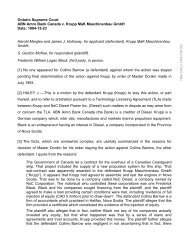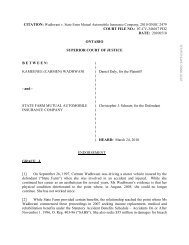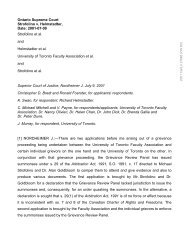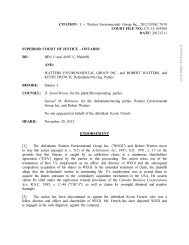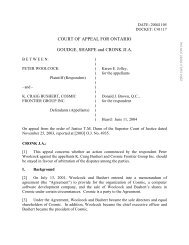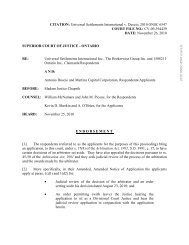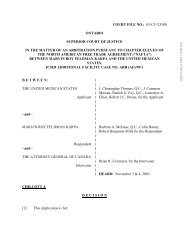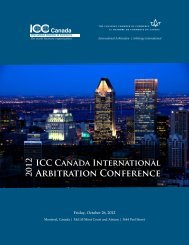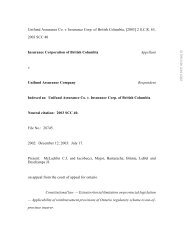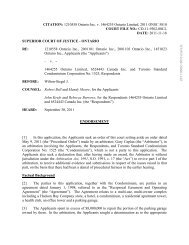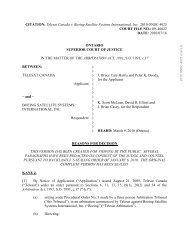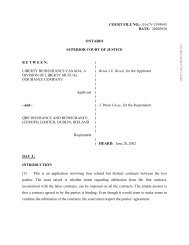McKinstry v York Condominium Corp 2003 CanLII ... - Arbitration Place
McKinstry v York Condominium Corp 2003 CanLII ... - Arbitration Place
McKinstry v York Condominium Corp 2003 CanLII ... - Arbitration Place
You also want an ePaper? Increase the reach of your titles
YUMPU automatically turns print PDFs into web optimized ePapers that Google loves.
COURT FILE NO.: 01-CV-219697CM<br />
DATE: <strong>2003</strong>1208<br />
ONTARIO<br />
SUPERIOR COURT OF JUSTICE<br />
B E T W E E N: )<br />
)<br />
WILLIAM MCKINSTRY AND BEVERLY<br />
ANN DEMPSTER<br />
- and -<br />
Plaintiffs<br />
YORK CONDOMINIUM CORPORATION<br />
NO. 472 AND WILLIAM VERRIER<br />
Defendants<br />
)<br />
)<br />
)<br />
)<br />
)<br />
)<br />
)<br />
)<br />
)<br />
)<br />
)<br />
)<br />
)<br />
)<br />
Robert B. Cohen, for the plaintiffs<br />
Lloyd Cadsby, for the defendants<br />
HEARD: October 9, 10, 14, 15, 16, 17,<br />
<strong>2003</strong><br />
<strong>2003</strong> <strong>CanLII</strong> 22436 (ON SC)<br />
JURIANSZ J.<br />
[1] This case raises for the first time the interpretation and application of ss. 132 and 135 of<br />
the <strong>Condominium</strong> Act, 1998, S.O. c.19 (the “Act”), and their relationship to each other.<br />
The Facts<br />
[2] The defendant, <strong>York</strong> <strong>Condominium</strong> <strong>Corp</strong>oration No. 472 ("YCC 472"), is one of two<br />
buildings in an upscale condominium complex known as Granite <strong>Place</strong> in Toronto. The<br />
defendant, William Verrier, was the president of the Board of Directors of YCC 472 at the time<br />
of the events.<br />
[3] The plaintiffs, William <strong>McKinstry</strong> and Beverly Ann Dempster, are long-time residents of<br />
the complex and who, from time to time, have purchased, renovated, and resold condominium<br />
units in the complex and elsewhere.<br />
[4] The plaintiffs purchased suite 302 in YCC 472 with the intention of renovating and<br />
reselling it. They became the registered owners of suite 302 on August 10, 2001. Suite 302 was<br />
somewhat notorious in the building. Ms. Dempster described it as "unique in its decoration".<br />
There were loud colors on the walls and floors. The electrical and plumbing services and some
Page: 2<br />
internal walls had been altered. Significantly, the master bedroom and the main bathroom had<br />
been made into an open area and a Jacuzzi had been installed. Some heating vents and airconditioning<br />
intake vents had been blocked. Carpeting had been glued to the balcony damaging<br />
it, and tinting had been applied to the windows. Radiator leaks had damaged some of the wood<br />
flooring. The unit had been on the market for some seven months. The plaintiffs bought it for<br />
$380,000.<br />
[5] Suite 302 was on the southwest corner of the building. The living room was on the west<br />
side, overlooking a parking lot. The master bedroom and the bedroom/den were on the south<br />
side, overlooking a cemetery. The unit's terrace was on the west side connected to the living<br />
room.<br />
[6] With the knowledge and consent of building manager, the plaintiffs proceeded with<br />
dismantling the alterations made by the previous owners and rectifying the plumbing and<br />
electrical services. They testified the wall between the bedroom and the bedroom/den, had been<br />
moved a couple of feet to the east by the previous owners, and had to be torn down because it<br />
was blocking a vent. When the plaintiffs removed that wall, the plaintiffs remarked that the<br />
resulting larger space would make an attractive living room with a southern view, and that the<br />
existing living room could be split to create a bedroom and bedroom/den on the west side. They<br />
made the decision to reconfigure the suite on August 22. They considered the new layout so<br />
attractive that they decided to live in the unit rather than sell it, and listed their own residence for<br />
sale.<br />
<strong>2003</strong> <strong>CanLII</strong> 22436 (ON SC)<br />
[7] The plaintiffs proceeded to erect the metal studding framework for the walls of the new<br />
layout. Their work on the renovation continued until September 5 when the Board of Directors of<br />
YCC 472 ordered them to cease the work immediately. Thereafter, on September 10, 2001, the<br />
Board of Directors resolved that it would not approve the plaintiffs' proposed reconfiguration of<br />
suite 302 and required the plaintiffs to complete their renovation in accordance with the suite's<br />
“as constructed” layout; that is with the living room facing west and the bedroom and<br />
bedroom/den facing south.<br />
[8] On September 11, the next day, the plaintiffs agreed to comply with the Board's<br />
requirements. They removed the metal studding framework they had already installed and<br />
completed the renovation of the suite in accordance with its original layout. However, they no<br />
longer wished to live there. After completing the renovation they sold the suite 302 for $530,000.<br />
[9] The house rules of YCC 472 provide that planned alterations that are expected to take<br />
longer than four weeks require the written approval of the Board of Directors. The building<br />
manager can approve renovations expected to take less than four weeks. It is not contested that<br />
the plaintiffs’ renovation, with the reconfiguration of the suite, would have taken longer than<br />
four weeks. The plaintiffs recognize that they proceeded without express Board approval of the<br />
renovation. They claim that there was an established past practice of the Board not enforcing the<br />
house rules regarding renovations and so they had a reasonable expectation that the rules would<br />
not be enforced strictly in their case. They claim that the building manager of YCC 472 had
Page: 3<br />
approved their construction. They claim that Mr. Verrier, the president of the Board, represented<br />
to them that the Board that would approve their plans. They claim that by relying on the approval<br />
of the building manager and the representation of Mr. Verrier, they incurred construction,<br />
financing, and legal costs, suffered a loss of profit on the resale of the suite, and had to pay<br />
capital gains tax on the sale proceeds. They also seek punitive damages.<br />
[10] The position of the defendant Verrier is that he acted as president of the Board of<br />
Directors at all times and that he is not personally liable for the plaintiffs’ claims. At the end of<br />
the trial the plaintiffs consented to a dismissal of their claims against him.<br />
[11] The position of the defendant YCC 472 is that its refusal to approve the plaintiffs'<br />
proposed reconfiguration of the unit was a reasonable exercise of its authority. Mr. Verrier and<br />
another director testified that the decision was based on three concerns. First and primarily, the<br />
Board was concerned that the relocation of the living and dining room areas of suite 302 would<br />
increase the noise heard in the bedrooms of the unit owners on the floors immediately above and<br />
below the suite. Second, the Board did not want to set a precedent. The Board was concerned<br />
that if it permitted this renovation, it would have to approve other future major renovations and<br />
that uncontrolled major changes to the standard unit layouts would result in a reduction in the<br />
value of all units in the building. Third, the Board was concerned that major deviation from the<br />
“as constructed” layout of walls would interfere with designed airflows, perhaps leading to<br />
excessive heat, and that future purchasers of the unit might be able to hold the Board responsible<br />
for such deficiencies because it had approved the changes.<br />
<strong>2003</strong> <strong>CanLII</strong> 22436 (ON SC)<br />
[12] The plaintiffs also claim that YCC 472 failed to fulfill its obligation to correct<br />
deficiencies in the windows and terrace of the unit. YCC 472’s position is that the deficiencies<br />
were caused by unapproved alterations made by the previous owners, and were apparent at the<br />
time the plaintiffs purchased the unit.<br />
[13] The defendants take the position that the court lacks any jurisdiction to entertain the<br />
plaintiffs' claim because the plaintiffs did not resort to mediation and arbitration as required by<br />
s. 132(4) of the Act which provides:<br />
Every declaration shall be deemed to contain a provision that the corporation and<br />
the owners agree to submit a disagreement between the parties with respect to the<br />
declaration, by-laws or rules to mediation and arbitration in accordance with<br />
clauses (1) (a) and (b) respectively.<br />
[14] The plaintiffs take the position that the defendants have waived the application of<br />
s. 132(4) by not raising it earlier.<br />
[15] As well, the plaintiffs are seeking an oppression remedy pursuant to s. 135 of the Act.<br />
They claim that the Board's refusal to approve the reconfiguration of the unit was unreasonable,<br />
beyond the authority of YCC 472, and that it was oppressive, unfairly prejudicial to them, and<br />
unfairly disregarded their interests. They claim compensation under s. 135 of the <strong>Condominium</strong><br />
Act, 1998. Section 135 provides:
Page: 4<br />
(1) An owner, a corporation, a declarant or a mortgagee of a unit may make<br />
an application to the Superior Court of Justice for an order under this section.<br />
(2) On an application, if the court determines that the conduct of an owner, a<br />
corporation, a declarant or a mortgagee of a unit is or threatens to be oppressive or<br />
unfairly prejudicial to the applicant or unfairly disregards the interests of the<br />
applicant, it may make an order to rectify the matter.<br />
(3) On an application, the judge may make any order the judge deems proper<br />
including,<br />
(a) an order prohibiting the conduct referred to in the application; and<br />
<strong>2003</strong> <strong>CanLII</strong> 22436 (ON SC)<br />
(b) an order requiring the payment of compensation.<br />
[16] The defendants take the position that the mediation and arbitration requirement of<br />
s. 132(4) applies to s. 135 and that the plaintiffs cannot resort to the oppression remedy until they<br />
have exhausted mediation and arbitration. The plaintiffs submit that s. 132(4) does not apply to<br />
s. 135, and that even if they cannot proceed with their ordinary claims because of their failure to<br />
arbitrate, they can nevertheless proceed under s. 135.<br />
Interpreting Sections 132 and 135 of the <strong>Condominium</strong> Act, 1998<br />
[17] It is appropriate that I express a first impression of these provisions before applying them<br />
to the facts of this case.<br />
[18] Section 10 of the Interpretation Act, R.S.O. 1990, c. I.11 requires that these provisions<br />
be given a fair, large and liberal construction and interpretation.<br />
Subsection 132(4)<br />
[19] The Legislature's objective in enacting s. 132 is to enable the resolution of disputes<br />
arising within a condominium community through the more informal procedures of mediation<br />
and arbitration. To attain this objective, the phrase "with respect to the declaration, by-laws or<br />
rules" in s. 132(4), which applies to disagreements between owners and the condominium<br />
corporation, should be given a generous interpretation. It applies, in my view, to disagreements<br />
about the validity, interpretation, application, or non-application of the declaration, by-laws and<br />
rules. It must be noted that s. 132(4) does not require owners and condominium corporations to<br />
submit disagreements with respect to the Act to mediation and arbitration.<br />
[20] The first issue is whether s. 132(4) applies where the initiating party wishes to claim<br />
damages resulting from the disagreement as well as resolving the dispute. The term<br />
“disagreements” in s. 132(4) should be interpreted broadly to encompass claims for damages<br />
arising from the subject matter of the disagreement. Such a broad interpretation is most<br />
consistent with the provision’s objective of resolving disputes by informal procedures rather than
Page: 5<br />
by court action. A great many disagreements about declarations, by-laws and rules will be about<br />
responsibility for expenditures or about damage caused by failings or neglect. Imposing<br />
mediation and arbitration to resolve these disagreements, but requiring court action to claim<br />
money somehow at issue because of the disagreement, would frustrate the provision’s aim to<br />
have disputes resolved quickly and efficiently.<br />
[21] The <strong>Arbitration</strong> Act, 1991, S.O. 1991, c. 17 applies to arbitration required by s. 132(4).<br />
The terms of s. 132(4) refer to “arbitration in accordance with clauses (1)(a) and (b)” of s. 132.<br />
Subsection 132(1) refers to arbitration under the <strong>Arbitration</strong> Act, 1991. In any event, s. 2(3) of<br />
the <strong>Arbitration</strong> Act, 1991 provides that the <strong>Arbitration</strong> Act, 1991 applies to arbitration conducted<br />
in accordance with another Act, unless provided otherwise. Section 6 of the <strong>Arbitration</strong> Act,<br />
1991 indicates that a court's ability to intervene in matters governed by the <strong>Arbitration</strong> Act, 1991<br />
is extremely limited.<br />
<strong>2003</strong> <strong>CanLII</strong> 22436 (ON SC)<br />
[22] That the <strong>Arbitration</strong> Act, 1991 applies supports an interpretation of s. 132(4) as<br />
encompassing a claim for damages. The <strong>Arbitration</strong> Act, 1991 ensures the parties’ rights to fair<br />
procedures, has a number of provisions that make it clear duplication between an arbitration and<br />
court action is to be avoided, and provides a process for enforcement of an arbitrator’s decision.<br />
[23] Section 138 of the Courts of Justice Act, R.S.O. 1990, c. C.43 lends further support for<br />
the interpretation that arbitration under s. 132(4) may decide claims for damages by providing<br />
that “[a]s far as possible, multiplicity of legal proceedings shall be avoided”. It makes little sense<br />
to have two separate proceedings, one to resolve the disagreement and a second to deal with<br />
damages arising from the disagreement.<br />
[24] Counsel for the defendants, relying on Weber v. Ontario Hydro, [1995] 2 S.C.R 929,<br />
submitted that s. 132(4) of the <strong>Condominium</strong> Act, 1998 deprives the court of any jurisdiction to<br />
deal with matters to which it applies, just as the mandatory arbitration clause does in the labour<br />
regime. I find that this is not entirely the case. The distinction is that the <strong>Arbitration</strong> Act, 1991<br />
does not apply to arbitrations pursuant to the mandatory arbitration provision of the Labour<br />
Relations Act, R.S.O. 1995 c. 1, whereas it does to arbitrations pursuant to the <strong>Condominium</strong> Act,<br />
1998. The <strong>Arbitration</strong> Act, 1991 contemplates situations where the court may entertain a<br />
proceeding about matters subject to arbitration. Subsection 7(1) of the <strong>Arbitration</strong> Act, 1991 does<br />
provide that the court shall, on motion, stay a proceeding that is commenced in respect of a<br />
matter to be submitted to arbitration. However, s. 7(2) provides that the court may refuse to stay<br />
a proceeding for a number of reasons, such as undue delay in bringing the motion to stay the<br />
proceeding or the matter is a proper one for default or summary judgment. Thus it is clear that<br />
matters subject to arbitration may proceed in court in some circumstances.<br />
[25] Section 7 of the <strong>Arbitration</strong> Act, 1991 has been applied in the context of other statutory<br />
regimes. For example, in Boucher v. Soo Homes Inc. (1980), 16 R.P.R. 119, the court had before<br />
it an action where there had not been compliance with s. 17(4) of The Ontario New Home<br />
Warranties Plan Act, 1976, S.O. 1976, c. 52 [now Ontario New Warranties Plan Act, R.S.O.<br />
1990, c. O.31 which provided:
Page: 6<br />
Every agreement between a vendor and prospective owner shall be deemed to<br />
contain a written agreement to submit present or future differences to arbitration,<br />
subject to appeal to the Supreme Court [now Divisional Court, as of R.S.O.<br />
1990, c. O.31], and the <strong>Arbitration</strong>s Act applies.<br />
[26] Stortini D.C.J. found that the defendant had waived its right to arbitration by failing to<br />
move for a stay of action prior to delivery of its statement of defence. He relied upon Cole v.<br />
Can. Fire Ins. Co. (1908), 15 O.L.R. 336, a decision of the Divisional Court of Ontario that held<br />
that the power given to the court to stay proceedings under the <strong>Arbitration</strong>s Act is upon an<br />
application after appearance and before pleading or any other step in the proceedings. He<br />
concluded that a motion to stay brought after delivery of the statement of defence must be<br />
refused. In Cole, Riddell J. states, at p.338, that the fact that the right to arbitration is given by<br />
legislation does not make that right, when given, any higher than if it had been obtained by<br />
private contract. Riddell J. also states that if the defendants choose to put in a pleading rather<br />
than move for a stay, they must be held to have elected that method of having their rights<br />
determined, and to have waived the provision for arbitration.<br />
<strong>2003</strong> <strong>CanLII</strong> 22436 (ON SC)<br />
[27] Boucher was followed more recently in Chewins v. El-Equip Inc., [1996] O.J. No. 1865<br />
(Ont. Gen. Div.). The principles articulated in these cases should apply in the context of the<br />
<strong>Condominium</strong> Act, 1998.<br />
Section 135<br />
[28] The legislative objective of s. 135 is to grant the court the jurisdiction to protect<br />
condominium owners, corporations, declarants, and mortgagees from unfair treatment. The text<br />
of s. 135 has much in common with the corporate oppression remedy. Section 248 of the<br />
Business <strong>Corp</strong>orations Act, R.S.O. 1990, c. B.16 provides:<br />
(1) A complainant and, in the case of an offering corporation, the Commission<br />
may apply to the court for an order under this section.<br />
(2) Where, upon an application under subsection (1), the court is satisfied that<br />
in respect of a corporation or any of its affiliates,<br />
(a)<br />
(b)<br />
(c)<br />
any act or omission of the corporation or any of its affiliates effects<br />
or threatens to effect a result;<br />
the business or affairs of the corporation or any of its affiliates are,<br />
have been or are threatened to be carried on or conducted in a<br />
manner; or<br />
the powers of the directors of the corporation or any of its affiliates<br />
are, have been or are threatened to be exercised in a manner,
Page: 7<br />
that is oppressive or unfairly prejudicial to or that unfairly disregards the interests<br />
of any security holder, creditor, director or officer of the corporation, the court<br />
may make an order to rectify the matters complained of.<br />
[29] Lord Wilberforce in Ebrahimi v. Westbourne Galleries Ltd., [1972] 2 All E.R. 492 (H.L.)<br />
at 535 indicated that a statutory provision such as this provides a bridge to the principles of<br />
equity and gives the court a broad jurisdiction to subject the exercise of legal rights to equitable<br />
considerations:<br />
Acts which, in law, are valid exercises of powers conferred by the articles may<br />
nevertheless be entirely outside what can fairly be regarded as having been in the<br />
contemplation of the parties when they became members of the company.<br />
<strong>2003</strong> <strong>CanLII</strong> 22436 (ON SC)<br />
[30] This passage shows that the parties’ reasonable expectations are worthy of protection,<br />
and reasonable expectations have become a benchmark in the application of the corporate<br />
oppression remedy. Farley J. observed in 820099 Ontario Inc. v. Harold E. Ballard Ltd. (1992),<br />
3 B.L.R. (2d) 113 at para. 129:<br />
Shareholder interests would appear to be intertwined with shareholder<br />
expectations. It does not appear to me that the shareholder expectations which are<br />
to be considered are those that a shareholder has as his own individual "wish list".<br />
They must be expectations which could be said to have been (or ought to have<br />
been considered as) part of the compact of the shareholders.<br />
[31] The Supreme Court of Canada adopted the following often-quoted description of the<br />
corporate remedy in Loewen, Ondaatje, McCutcheon & Co. c. Sparling (1992), 97 D.L.R. (4th)<br />
616 at 631-632 from D.H. Peterson, Shareholder Remedies in Canada (Toronto: Butterworths,<br />
1989) at para. 18.1, p. 18.1. :<br />
The oppression remedy may be considered the Charter of Rights and Freedoms of<br />
corporate law. It is a relatively new creature of statute, so it is little developed. It<br />
is broad and flexible, allowing any type of corporate activity to be the subject of<br />
judicial scrutiny. The potential protection it offers corporate stakeholders is<br />
awesome. Nevertheless, the legislative intent of the oppression remedy is to<br />
balance the interests of those claiming rights from the <strong>Corp</strong>oration against the<br />
ability of management to conduct business in an efficient manner.<br />
[32] After quoting this passage, the Supreme Court said of the corporate remedy in the<br />
Canada Business <strong>Corp</strong>orations Act, R.S.C. 1985, c. C-44:<br />
This remedy thus requires an interpretation consistent with its purpose. Cory J.A.,<br />
as he then was, summarized this principle in Sparling v. Royal Trustco Ltd., supra,<br />
at p. 693: "Here the C.B.C.A. has sought to provide a remedy. An interpretation<br />
which gives effect to the remedy is preferable to one which seeks to restrict or<br />
eliminate the remedial provision of the Act." And at p. 694: "Where a statute
Page: 8<br />
provides a remedy, its scope should not be unduly restricted. Rather, the courts<br />
should seek to provide the means to effect that remedy."<br />
[33] This interpretative principle and the foregoing passages apply to s. 135 of the<br />
<strong>Condominium</strong> Act, 1998. This new creature of statute should not be unduly restricted but given a<br />
broad and flexible interpretation that will give effect to the remedy it created. Stakeholders may<br />
apply to protect their legitimate expectations from conduct that is unlawful or without authority,<br />
and even from conduct that may be technically authorized and ostensibly legal. The only<br />
prerequisite to the court’s jurisdiction to fashion a remedy is that the conduct must be or threaten<br />
to be oppressive or unfairly prejudicial to the applicant, or unfairly disregard the interests of the<br />
applicant. Once that prerequisite is established, the court may “make any order the judge deems<br />
proper” including prohibiting the conduct and requiring the payment of compensation. This<br />
broad powerful remedy and the potential protection it offers are appropriately described as<br />
“awesome”. It must be remembered that the section protects legitimate expectations and not<br />
individual wish lists, and that the court must balance the objectively reasonable expectations of<br />
the owner with the condominium board's ability to exercise judgment and secure the safety,<br />
security and welfare of all owners and the condominium's property and assets.<br />
<strong>2003</strong> <strong>CanLII</strong> 22436 (ON SC)<br />
[34] I reject the defendants' submission that the words "is or threatens to be" in s. 135(2) limits<br />
the remedy to conduct that is present or prospective. Section 4 of the Interpretation Act, R.S.O.<br />
1990, c.I.11 provides that "the law shall be considered as always speaking and, where a matter or<br />
thing is expressed in the present tense, it is to be applied to the circumstances as they arise, so<br />
that effect may be given to each Act and every part of it according to its true intent and<br />
meaning". Moreover, s. 135(3) allows the court to prohibit the conduct or to make an order<br />
requiring the payment of compensation. Prohibiting the conduct would be appropriate where the<br />
conduct is threatened or taking place. Ordering compensation would be appropriate when the<br />
conduct has already taken place.<br />
The Relationship of Subsection 132(4) and Section 135<br />
[35] While s. 132(4) applies to "disagreements" and s. 135 applies to "conduct", there are<br />
circumstances where both provisions might seem to apply. For example, where an owner and a<br />
condominium corporation disagree about the meaning and proper application of the rules, the<br />
owner might allege that conduct that the corporation was taking or was threatening to take on its<br />
view of the rules was oppressive. Subsection 132(4) would apply to the disagreement, and s. 135<br />
would apply to the threatened conduct. There is much scope for overlap as s. 135 could be<br />
invoked to impugn a decision or course of action purportedly taken or threatened to be taken<br />
under the declaration, by-laws or rules.<br />
[36] This leads to the question of whether s. 132(4) requires an applicant to submit to<br />
mediation and arbitration the subject matter of a s. 135 application where the conduct or<br />
threatened conduct is related to the declaration, by-laws or rules. The question is of considerable<br />
importance to the ambit of both sections. The <strong>Arbitration</strong> Act, 1991 provides for the binding<br />
determination of the dispute between the parties. That is, if the arbitration were required before a
Page: 9<br />
s. 135 application could be brought about conduct or threatened conduct related to the<br />
declaration, by-laws or rules, then s. 135 would not be practically available in many cases. On<br />
the other hand, if resort to mediation and arbitration were not required, then the legislative goal<br />
of resolving disputes within the condominium corporation by these informal procedures would<br />
be significantly circumscribed.<br />
[37] There are several reasons why I conclude that s. 132(4) does not require an applicant<br />
under section 135 to first resort to mediation and arbitration where the conduct complained of is<br />
related to a disagreement with respect to the declaration, by-laws or rules.<br />
[38] First, section 135 states, without qualification, that an application may be made to the<br />
Superior Court of Justice.<br />
<strong>2003</strong> <strong>CanLII</strong> 22436 (ON SC)<br />
[39] Second, many section 135 applications will be about a broad pattern of conduct, only a<br />
part of which is subject to s. 132(4). For example, a s. 135 application may complain of conduct<br />
both with respect to "the declaration, the by-laws or rules" and other conduct. I have already<br />
noted that s. 132(4) does not apply to disagreements between the parties with respect to the Act.<br />
A s. 135 application may be about conduct related to both the Act and by-laws. Making one part<br />
of such a broad application subject to mediation and arbitration would result in multiple<br />
proceedings.<br />
[40] Third, the legislative intent that s. 132(4) does not apply to applications under s. 135 is<br />
apparent from the statute itself. Sections 132 and 135 are in Part IX, titled "Enforcement", of the<br />
Act. Another section in that Part, subsection 134(1), contemplates an application to the Superior<br />
Court of Justice for an order enforcing compliance with any provision of the Act, declaration, bylaws<br />
or rules. Subsection 134(2) states: “If the mediation and arbitration processes described in<br />
section 132 are available, a person is not entitled to apply for an order under subsection (1) until<br />
the person has failed to obtain compliance through using those processes”. There is no similar<br />
provision in s. 135 (or in ss. 130(1), 131(1), and 133(2) which also contemplate applications to<br />
the Court). The pointed inclusion of an explicit requirement to exhaust mediation and arbitration<br />
in s. 134, but not in s. 135, implies the Legislature did not intend that applicants seeking the<br />
oppression remedy must first resort to mediation and arbitration.<br />
[41] Fourth, s. 135 applies to conduct or threatened conduct, and under section 135(3)(a) the<br />
court may prohibit the conduct. This makes clear that parties may resort to s. 135 with respect to<br />
conduct that has not taken place as yet, in order to prevent it from taking place. Such an<br />
application must be brought with dispatch and determined promptly in order to be effective. The<br />
time required to schedule and proceed with mediation and arbitration are not compatible with the<br />
dispatch that many section 135 applications would require.<br />
[42] I conclude that a s. 135 applicant does not have to first resort to mediation and arbitration<br />
even though the conduct complained of may be related to a disagreement about the declaration,<br />
by-laws or rules.
Page: 10<br />
Application to this Case<br />
[43] In this case the plaintiffs proceeded by way of action and invoked the court's jurisdiction<br />
under s. 135 of the <strong>Condominium</strong> Act, 1998 by way of an amendment to their statement of claim.<br />
The defendants responded by pleading in their Amended Amended Statement of Defence that the<br />
condominium Board acted within its authority and reasonably. In closing argument the<br />
defendants, for the first time, argued that this court was without jurisdiction to give a remedy<br />
under section 135 because the plaintiffs had proceeded by way of action and s. 135 contemplates<br />
the making of "an application". I did not have the benefit of extensive argument of this issue, and<br />
neither side provided any authorities. Defendants' counsel did not provide any policy reason why<br />
it was important that a s. 135 applicant must proceed by way of application. Nor did defendants'<br />
counsel identify any prejudice to the defendants resulting from the fact the plaintiffs proceeded<br />
by way of action in this case. The defendants have had full discovery of the plaintiffs' position.<br />
In the circumstances of this case I regard the defendants' argument as unduly technical. I<br />
consider that the plaintiffs have made an application to the court under s. 135 within their action.<br />
<strong>2003</strong> <strong>CanLII</strong> 22436 (ON SC)<br />
[44] In this case, the defendants must be taken to have waived the application of s. 132(4) as<br />
they raised it for the first time in their Amended Statement of Defence, amended February <strong>2003</strong>,<br />
after all examinations for discovery had been completed. That was too late for the defendants to<br />
raise the issue. In any event, the plaintiffs’ s. 135 application, brought within their action, is not<br />
subject to s. 132(4).<br />
[45] The foregoing results in the situation where the plaintiffs are claiming damages for<br />
causes of action, such as detrimental reliance, and applying for relief under section 135 in respect<br />
of the same conduct. There is only one dispute between the parties. Section 135 is broad enough<br />
to encompass all the claims except for punitive damages. As I have concluded that all the<br />
plaintiff's claims, however characterized, must be dismissed I do not distinguish between the<br />
plaintiffs' action and s. 135 application in my analysis of the evidence and issues.<br />
The Merits of the Plaintiffs’ Claims<br />
The House Rules<br />
[46] Article VII of YCC 472's house rules deals with "alterations, traditions and renovations"<br />
in the following terms:<br />
(1) Any owner/tenant having alterations done in his or her suite shall not permit<br />
anything to be done that will obstruct to interfere with the rights of other<br />
owners/tenants or in any way have a detrimental effect on other suites in the<br />
common elements. Noise and nuisance should be kept to a minimum. It is also an<br />
imperative that the appearance of the building be protected and that its structural<br />
integrity be safeguarded. Any owner/tenant having work done is expected to<br />
follow not only the letter of this Article but also its spirit.
Page: 11<br />
(2) Any owner/tenant planning alterations must have his/her plan approved in<br />
writing by the manager before any work is begun. Depending on the nature of the<br />
alterations, Board approval may be required and the manager will advise the<br />
owner/tenant accordingly. If the planning alterations will take longer than four (4)<br />
weeks, written Board approval is required.<br />
….<br />
(7) In the event that there is a change in or deviation from the plans approved by<br />
the manager or the Board, as the case may be, such change or deviation, however<br />
slight, cannot be proceeded with until the manager has approved the change or<br />
deviation in writing.<br />
<strong>2003</strong> <strong>CanLII</strong> 22436 (ON SC)<br />
(8) Management has the right to monitor work being done in a suite. In enforcing<br />
the declaration and house rules, the manager or a member of the building staff<br />
may enter the suite and may order that work be halted.<br />
(Underlining added)<br />
[47] I am satisfied that these rules are a proper exercise of the Board’s authority, granted by s.<br />
58 of the <strong>Condominium</strong> Act, 1998.<br />
Alleged Approval of the Renovation by Building Management<br />
[48] The evidence of the building manager, Mr. Bill Colucci, and of building maintenance<br />
staff, Mr. Ernesto Frugoni, that they did not represent to the plaintiffs that their plans to<br />
reconfigure the suite was acceptable was uncontradicted. Mr. Frugoni explained he did not see it<br />
as his role to discuss the project with the plaintiffs at all. Rather, his duty was to make periodic<br />
inspections and make reports to building management.<br />
[49] At one point of her cross-examination, Ms. Dempster indicated that Bill Colucci had<br />
given approval to the plaintiffs' reconfiguration plan on or about August 22. When pressed for<br />
details, she indicated that she was not in the suite when Mr. Colucci allegedly gave approval. A<br />
few answers later, she indicated that she did not even have personal knowledge that Mr. Colucci<br />
was there at that time, and suggested the question be addressed to Mr. <strong>McKinstry</strong>.<br />
Mr. <strong>McKinstry</strong> did not testify that Mr. Colucci expressed any approval of the plans to<br />
reconfigure the suite.<br />
[50] The plaintiffs pointed to the notices Mr. Colucci had posted in the building advising other<br />
residents of the construction. Certainly building management was aware of the fact that the<br />
plaintiffs were renovating suite 302. Building maintenance and management were there from<br />
time to time and other residents and board members must be taken to have read the notices.<br />
Mr. Verrier himself visited the suite on at least one occasion before August 22 while demolition<br />
was taking place.
Page: 12<br />
[51] A critical observation is that when Mr. Colucci posted the notices on August 14 and 21,<br />
he could not have been aware of the plaintiffs' proposed reconfiguration of the suite, as the<br />
plaintiffs testified that they did not decide to reconfigure the suite until the afternoon of August<br />
22. The plaintiffs simply could not have understood these notices as approval of the<br />
reconfiguration of the layout of the suite.<br />
[52] Mr. Colucci had discretion under the house rules to approve alterations that would take<br />
less than four weeks. The notice dated August 14 indicates that the work was expected to take<br />
approximately three weeks. Mr. Colucci testified that this information came from the plaintiffs.<br />
The notice dated August 21 advises that there will be construction noise "over the next few<br />
weeks" and that demolition will take place on August 22, when noise may be louder than at any<br />
other time. There was no evidence whatsoever that Mr. Colucci expressed approval of a<br />
renovation expected to take more than four weeks and which involved the reconfiguration of the<br />
suite.<br />
<strong>2003</strong> <strong>CanLII</strong> 22436 (ON SC)<br />
Alleged Approval of the Renovation by President of the Board<br />
[53] Ms. Dempster testified that at a meeting of August 22, about 4:30 p.m., she discussed<br />
with Mr. Verrier the plan to relocate the walls in the suite. She said that Mr. Verrier wanted<br />
clarification and suggested that Mr. Frugoni provide her with the floor plan of the original layout<br />
of the suite so that she could indicate on it where they planned to place the walls. She said that he<br />
asked that this be prepared by the time he returned from vacation just before the next Board<br />
meeting. She said that Mr. Verrier told her that as long as Mr. Colucci and Mr. Frugoni remained<br />
involved, Board approval would be a formality.<br />
[54] Later that day, Ms. Dempster sent Mr. Verrier an e-mail at 8:47. The e-mail was in<br />
evidence. Ms. Dempster testified that Mr. Verrier then left a voice-mail telephone message for<br />
her at 10:30 p.m. that night. Ms. Dempster testified that Mr. Verrier said in the voice-mail that<br />
the plaintiffs had obviously gone beyond what was required and there should be no problem with<br />
the renovation. She testified that the plaintiffs' decision to live in the unit rather than sell it was<br />
based on the approval of their plan to reconfigure the suite given in the voice-mail.<br />
Mr. <strong>McKinstry</strong> testified that Ms. Dempster conveyed to him the content of Mr. Verrier's voice<br />
message, and he relied on the message to proceed with erecting the partition walls in the existing<br />
living room area.<br />
[55] Mr. Verrier agreed in his testimony that he met with Ms. Dempster on August 22, and he<br />
agreed that he left her a voice-mail late that evening in which he said that as long as building<br />
maintenance and property management were content that all requirements were being met, then<br />
it was alright with him. However, Mr. Verrier testified that when he left this message, his<br />
understanding was still that the plaintiffs intended to restore the suite to the basic standard<br />
layout, and that he did not learn of their plans to reconfigure it until his return from vacation on<br />
September 5.
Page: 13<br />
[56] I do not accept Ms. Dempster's versions of the meeting and of Mr. Verrier's voice<br />
message for several reasons.<br />
[57] First, if Mr. Verrier had said in the afternoon meeting with Ms. Dempster that Board<br />
approval was a mere formality, his voice-mail added little. Yet, Mr. <strong>McKinstry</strong> did not testify<br />
about understanding that the reconfiguration plan had been approved at the afternoon meeting.<br />
He was clear that he understood from his communication with Ms. Dempster that the approval<br />
was given in the voice-mail later that night. I consider it highly likely that had Mr. Verrier said to<br />
Ms. Dempster in the afternoon that the Board's approval was a mere formality, she would have<br />
conveyed that to Mr. <strong>McKinstry</strong>.<br />
[58] Second, if Ms. Dempster had disclosed the plaintiffs' decision to reconfigure the suite at<br />
the afternoon meeting, and if Mr. Verrier had said at that meeting that Board approval was a<br />
mere formality, I would expect that Ms. Dempster would have made some reference to these<br />
communications in her later e-mail. That is not the case. The second paragraph refers to the<br />
"changes that we thought we'd have to make to bring the structure, plumbing, electrical, and<br />
vent/ducts back to the original suite design". The fourth paragraph said the plaintiffs had<br />
"requested a copy of the original suite plumbing/electrical/vent/duct drawings…. We will sign<br />
off that this is the plan that we are using (returning to)." The sixth paragraph referred to the<br />
"extended time we'll require to bring this back to Granite <strong>Place</strong> intention (6-8 weeks)". It is<br />
possible to read these statements of intention to return to the original design as limited to the<br />
building services and not applying to the layout of the walls. But the e-mail makes no reference<br />
to the decision to reconfigure the walls, a matter that was supposedly discussed with Mr. Verrier.<br />
To the contrary the e-mail also says "only today did we finalize with a designer where we would<br />
need to position the walls to ensure we could utilize the original facilities". This single oblique<br />
reference to the walls' position is interesting. The walls placed in their original "as constructed"<br />
location would utilize the original facilities. The plaintiff's planned placement of the walls was<br />
not a question of need but a matter of the plaintiffs' wishes. The further statement "we've been<br />
working from the visual within the suite to be able to assess just how extensive this renovation<br />
(in the true sense of the word!) will be" implies no final plan had been adopted.<br />
<strong>2003</strong> <strong>CanLII</strong> 22436 (ON SC)<br />
[59] Had the matter of a major relocation of the walls been discussed at the afternoon meeting,<br />
and had Mr. Verrier assured her that the Board's approval was a formality, I consider it certain<br />
that Ms. Dempster would have recapitulated that in the e-mail. I find the content of the coyly<br />
worded e-mail is inconsistent with what Ms. Dempster says took place at the afternoon meeting.<br />
[60] Third, Ms. Dempster's memory of the meeting does not seem strong. She initially said<br />
that Mary Wasser, Ernesto Frugoni, and "Bill", meaning Mr. <strong>McKinstry</strong>, were also at the<br />
meeting. She admitted in cross-examination that Mr. <strong>McKinstry</strong> was not at the meeting.<br />
[61] Fourth, Mr. Frugoni's testimony does not support Ms. Dempster's version. Mr. Frugoni<br />
did recall a meeting with Ms. Dempster and Mr. Verrier in Ms. Wasser's office. However, he<br />
could not say when the meeting he had in mind took place, but he was emphatic it was after the<br />
new wall dividing the living room had been partially constructed. Since I accept the plaintiffs’
Page: 14<br />
evidence that they did not start construction of the new walls until after August 22, I conclude<br />
that Mr. Frugoni recollected a different and later meeting. What is helpful in resolving the<br />
credibility issue is Mr. Frugoni's testimony, which I accept, in which he seemed to vividly<br />
recollect that he did not learn of the new walls until he saw the new wall dividing the living room<br />
almost completely built. I accept his testimony that no one told him new walls were going to be<br />
built in the apartment. This is inconsistent with Ms. Dempster's testimony that she indicated the<br />
plaintiffs' plans at the August 22 meeting with Mr. Verrier where Mr. Frugoni was present.<br />
[62] Fifth, I consider it unlikely that Mr. Verrier would informally indicate approval of a<br />
major project without the submission of a construction plan and without the Board's sanction one<br />
day after he circulated his Chairman’s Report, reviewed above, that "no contractor will be<br />
allowed access to the building until a renovation plan has been approved by Management."<br />
<strong>2003</strong> <strong>CanLII</strong> 22436 (ON SC)<br />
[63] Finally, I found Mr. Verrier's testimony credible. I do not accept plaintiff's counsel<br />
submission that Mr. Verrier's testimony at trial was impeached on numerous occasions as<br />
inconsistent with his examination for discovery. The matters on which Mr. Verrier was<br />
challenged were of such inconsequence that I found it difficult to understand what was alleged to<br />
be inconsistent.<br />
[64] I find as a fact that Ms. Dempster did not disclose the plaintiffs' plans to reconfigure the<br />
suite at the August 22 afternoon meeting and Mr. Verrier did not say at that meeting that Board<br />
approval of their plan to reconfigure the suite would be a formality.<br />
[65] This finding of fact has a determining effect on the question of whether Mr. Verrier<br />
conveyed approval in his voice-mail left later that night. Since Ms. Dempster did not indicate the<br />
walls were to be relocated at the afternoon meeting, and her later e-mail did not do so either, it<br />
may be concluded that Mr. Verrier did not know of the plaintiff's plans when he left the voicemail.<br />
Whatever he said in that voicemail could not have related to the plaintiffs' plan to<br />
reconfigure the layout of the suite.<br />
[66] I conclude that Mr. Verrier did not indicate the Board would approve the plaintiffs' plan<br />
to reconfigure the suite, or indicate that as long as the building manager and building<br />
maintenance were kept involved, the plan to reconfigure the suite would be acceptable.<br />
Unfairness<br />
[67] It remains to consider whether the Board's refusal to permit the plaintiffs to reconfigure<br />
the unit, while within the Board's legal authority, was oppressive or conduct that unfairly<br />
prejudiced them or unfairly disregarded their interests.<br />
[68] The plaintiffs assert an interest worthy of protection, as their claim relates to the use and<br />
enjoyment of their property. They point out that the floor layouts attached to the condominium's<br />
declaration show only demising walls and not internal walls. As such, they say they had a<br />
reasonable expectation that they would be able to rearrange the internal walls however they<br />
wished. I note that the plaintiffs' decision to purchase the unit was not dependent on getting
Page: 15<br />
approval to reconfigure it. Their communications to building management prior to August 22 are<br />
liberally sprinkled with references of how they "would be bringing this back to the original<br />
intended design". The impact of the Board's decision was that they had to revert to what was<br />
their original plan. I accept that once they had adopted the plan to reconfigure the suite, they<br />
decided to live there, and that the Board's decision greatly disappointed them. The Board's<br />
decision clearly interfered with how the plaintiffs wished to use and enjoy their property.<br />
[69] I have already explained why the plaintiffs could not have an objectively reasonable<br />
expectation that the house rules regarding renovations would not be enforced. In this case, I am<br />
satisfied that the three reasons given by the Board for disapproving the plaintiffs' proposed<br />
renovation are each a reasonable and legitimate concern of a condominium board saddled with<br />
the responsibility of balancing the interests of individual unit holders against the welfare of other<br />
unit owners and the building itself.<br />
<strong>2003</strong> <strong>CanLII</strong> 22436 (ON SC)<br />
[70] It is true, as the plaintiff points out, that the layout of a condominium unit cannot prevent<br />
the occupants from creating noise that disturbs other residents. It is also true that at several<br />
locations in the building, as it was designed, bedrooms are located immediately above or below<br />
living rooms. These situations arise at points between groups of floors in the building that have<br />
different unit layouts. Nevertheless, the concern that a living room beneath a bedroom<br />
contributes to noise disturbance is far from arbitrary, and in my view, a reasonable one. The units<br />
within a condominium abut each other closely, and Mr. Verrier explained that the mechanical<br />
aspects of the building, pipes, vents and so forth, conduct sound from one unit to another.<br />
Limiting the instances where a bedroom is above or below a living room to those points in the<br />
building where the floor layout changed from one group of floors to another group of floors may<br />
not eliminate noise problems but may reasonably be considered to reduce noise problems.<br />
[71] It is also true that one or two single units in the building had been turned into double<br />
units. There was no evidence as to whether these projects had been approved or not. The earlier<br />
renovation of suite 302 by the previous owners had not been approved. However, there was no<br />
change of rules in midstream that discriminated against the plaintiffs. Mr. Verrier was a new<br />
president of a new Board. The Board passed a resolution decrying the earlier unapproved<br />
construction projects, and gave all tenants notice of an intention to stiffen the enforcement of the<br />
house rules. There was no evidence that the plaintiffs were treated any differently than any other<br />
unit holder would have been. I regard as a legitimate consideration, the Board's concern that if it<br />
approved the plaintiffs' reconfiguration of their unit, the Board would have to treat other unit<br />
holders in the same way, and that this could diminish the overall value of the building because of<br />
haphazard and uncontrolled renovation. Suite 302 is an apt example. The plaintiffs emphasized<br />
the unconventional renovation of the previous owners. The unit was on the market for a<br />
prolonged period and the plaintiffs bought it for what seems an attractive price. The plaintiffs<br />
also emphasized that the previous renovation created hazardous conditions because building<br />
services were not handled properly.<br />
[72] I also consider as reasonably within the purview of the Board, its concern that relocating<br />
the internal walls of a unit might potentially interfere with the building's services, such as
Page: 16<br />
ventilation. I do not accept the plaintiffs’ submission that it was up to the Board to retain experts<br />
in this regard.<br />
[73] Nor did the plaintiffs persuade me that YCC 472’s decision not to rectify the deficiencies<br />
in the windows and the terrace, since those deficiencies were due to unapproved alterations made<br />
by the previous owners of the unit, was oppressive, unfairly prejudicial to them, or unfairly<br />
disregarded their interests.<br />
[74] The plaintiffs have not satisfied me that the Board's conduct in this case considered as a<br />
whole was oppressive, unfairly prejudicial to them, or unfairly disregarded their interests.<br />
Damages and Compensation<br />
<strong>2003</strong> <strong>CanLII</strong> 22436 (ON SC)<br />
[75] The plaintiffs claim a loss in the value of the suite. They argue that if the living room had<br />
a southern view, the suite would be worth some $80,000-$120,000 more. I did not find the<br />
testimony or report of the plaintiff’s expert persuasive in this regard. The expert had never been<br />
inside the suite and did not appreciate its actual layout before he prepared his opinion. For<br />
example, he had not considered that the plaintiffs' proposed reconfiguration would not have<br />
permitted access to the terrace from the living room. In any event, suite 302 eventually sold for<br />
$402 a square foot, which compares favorably with the highest comparable unit identified by the<br />
expert as having sold for $404 per square foot. I was not persuaded that a reconfigured suite 302<br />
would have had a greater market value.<br />
[76] The plaintiffs claim a loss of the capital gains exemption for a permanent residence<br />
because they decided not to live in suite 302 as a result of the Board's decision. While they may<br />
have lost the capital gains exemption on suite 302, they did enjoy the capital gains exemption on<br />
the unit in which they lived. As they led no evidence of the capital gain on that unit during the<br />
relevant time, they have failed to place before the court sufficient evidence to calculate any<br />
damage suffered in this regard.<br />
[77] The plaintiffs testified that they installed a multitude of fixtures and accoutrements of<br />
superior quality in suite 302 because they planned to live there. Mr. <strong>McKinstry</strong> did indicate his<br />
opinion that the cost of an upgrade in quality of a fixture could not be recovered in a subsequent<br />
sale. He was not qualified as an expert so his opinion was not strictly admissible. In any event,<br />
he did not state that there would be no enhancement in the selling price where an entire<br />
renovation was done with superior quality fixtures.<br />
[78] Had I been persuaded that the plaintiffs' claim had merit, I would assess their damages in<br />
the amount of $21,500. The evidence was that there was some $8,500 to $9,500 in lost<br />
construction costs, and about $13,000 in additional financing charges, condominium fees, and<br />
property taxes.
Page: 17<br />
Conclusion<br />
[79] The plaintiff's action and application under section 135 of the <strong>Condominium</strong> Act, 1998<br />
are dismissed.<br />
[80] The parties may schedule a date, through my secretary, to address costs.<br />
[81] Released: December 8, <strong>2003</strong><br />
___________________________<br />
Juriansz J.<br />
<strong>2003</strong> <strong>CanLII</strong> 22436 (ON SC)
COURT FILE NO.: 01-CV-219697CM<br />
DATE: <strong>2003</strong>1209<br />
ONTARIO<br />
SUPERIOR COURT OF JUSTICE<br />
B E T W E E N:<br />
William <strong>McKinstry</strong> and Beverly Ann Dempster<br />
Plaintiffs<br />
<strong>2003</strong> <strong>CanLII</strong> 22436 (ON SC)<br />
- and -<br />
<strong>York</strong> <strong>Condominium</strong> <strong>Corp</strong>oration No. 472 and<br />
William Verrier<br />
Defendants<br />
_________________________________________<br />
REASONS FOR JUDGMENT<br />
Juriansz J.<br />
Released: December 8, <strong>2003</strong>



